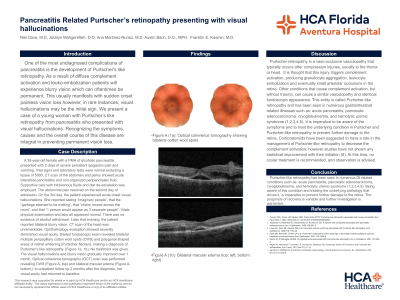Back


Poster Session A - Sunday Afternoon
Category: Biliary/Pancreas
A0060 - Pancreatitis-Related Purtscher's-Like Retinopathy Presenting With Visual Hallucinations
Sunday, October 23, 2022
5:00 PM – 7:00 PM ET
Location: Crown Ballroom

Has Audio

Niel Dave, MD
HCA Florida Aventura Hospital
Aventura, FL
Presenting Author(s)
Award: Presidential Poster Award
Niel Dave, MD1, Jacklyn Mahgerefteh, DO2, Ana Martinez, MD1, Austin Bach, DO2, Franklin Kasmin, MD1
1HCA Florida Aventura Hospital, Aventura, FL; 2Larkin Community Hospital, Miami, FL
Introduction: One of the most undiagnosed complications of pancreatitis is the development of Purtscher's like retinopathy. As a result of diffuse complement activation and leuko-embolization patients will experience blurry vision which can oftentimes be permanent. This usually manifests with sudden onset painless vision loss however, in rare instances, visual hallucinations may be the initial sign. We present a case of a young woman with Purtscher’s like retinopathy from pancreatitis who's initial symptom was visual hallucinations. Recognizing the signs, causes and the overall course of this disease are integral in preventing permanent vision loss.
Case Description/Methods: A 38 year female with a PMH of alcoholic pancreatitis presented with 2 days of severe persistent epigastric pain. Vital signs and laboratory tests were normal excluding a lipase of 5000 U/L. CT scan showed acute interstitial pancreatitis. Supportive care was employed. The abdominal pain resolved on the second day. On the 3rd day, the patient experienced acute onset visual hallucinations. She reported seeing “imaginary people”, “chairs are moving across the room”, and “1 person appears as 3 separate people”. There was no evidence of alcohol withdrawal. Later that evening, the patient reported sudden onset bilateral vision loss. CT scan of the head was unremarkable. Ophthalmology evaluation showed severely diminished visual acuity. Dilated fundoscopic exam revealed bilateral multiple peripapillary cotton wool spots (CWS) and polygonal shaped areas of retinal whitening (Purtscher flecken), making a diagnosis of Purtscher’s like retinopathy. Optical coherence tomography (OCT) scan was performed 2 weeks later revealing CWS and bilateral macular edema (Figure A). No treatment was given. The visual hallucinations and blurry vision gradually improved over 1 month. 2 months after the diagnosis, her visual acuity had returned to baseline.
Discussion: Purtscher's like retinopathy is a severe vaso-occlusive vasculopathy. Severe systemic illnesses or traumas trigger complement activation and leukocyte embolization causing arteriolar occlusions in the retina. This has been associated with numerous gastrointestinal related illnesses such as: acute pancreatitis, pancreatic adenocarcinoma, cryoglobulinemia, and hemolytic uremic syndrome. It is imperative to be aware of the symptoms and to treat the underlying condition in Purtscher-like retinopathy to prevent further damage to the retina. At this time, no ocular treatment is recommended.

Disclosures:
Niel Dave, MD1, Jacklyn Mahgerefteh, DO2, Ana Martinez, MD1, Austin Bach, DO2, Franklin Kasmin, MD1. A0060 - Pancreatitis-Related Purtscher's-Like Retinopathy Presenting With Visual Hallucinations, ACG 2022 Annual Scientific Meeting Abstracts. Charlotte, NC: American College of Gastroenterology.
Niel Dave, MD1, Jacklyn Mahgerefteh, DO2, Ana Martinez, MD1, Austin Bach, DO2, Franklin Kasmin, MD1
1HCA Florida Aventura Hospital, Aventura, FL; 2Larkin Community Hospital, Miami, FL
Introduction: One of the most undiagnosed complications of pancreatitis is the development of Purtscher's like retinopathy. As a result of diffuse complement activation and leuko-embolization patients will experience blurry vision which can oftentimes be permanent. This usually manifests with sudden onset painless vision loss however, in rare instances, visual hallucinations may be the initial sign. We present a case of a young woman with Purtscher’s like retinopathy from pancreatitis who's initial symptom was visual hallucinations. Recognizing the signs, causes and the overall course of this disease are integral in preventing permanent vision loss.
Case Description/Methods: A 38 year female with a PMH of alcoholic pancreatitis presented with 2 days of severe persistent epigastric pain. Vital signs and laboratory tests were normal excluding a lipase of 5000 U/L. CT scan showed acute interstitial pancreatitis. Supportive care was employed. The abdominal pain resolved on the second day. On the 3rd day, the patient experienced acute onset visual hallucinations. She reported seeing “imaginary people”, “chairs are moving across the room”, and “1 person appears as 3 separate people”. There was no evidence of alcohol withdrawal. Later that evening, the patient reported sudden onset bilateral vision loss. CT scan of the head was unremarkable. Ophthalmology evaluation showed severely diminished visual acuity. Dilated fundoscopic exam revealed bilateral multiple peripapillary cotton wool spots (CWS) and polygonal shaped areas of retinal whitening (Purtscher flecken), making a diagnosis of Purtscher’s like retinopathy. Optical coherence tomography (OCT) scan was performed 2 weeks later revealing CWS and bilateral macular edema (Figure A). No treatment was given. The visual hallucinations and blurry vision gradually improved over 1 month. 2 months after the diagnosis, her visual acuity had returned to baseline.
Discussion: Purtscher's like retinopathy is a severe vaso-occlusive vasculopathy. Severe systemic illnesses or traumas trigger complement activation and leukocyte embolization causing arteriolar occlusions in the retina. This has been associated with numerous gastrointestinal related illnesses such as: acute pancreatitis, pancreatic adenocarcinoma, cryoglobulinemia, and hemolytic uremic syndrome. It is imperative to be aware of the symptoms and to treat the underlying condition in Purtscher-like retinopathy to prevent further damage to the retina. At this time, no ocular treatment is recommended.

Figure: Optical coherence tomography showing bilateral cotton wool spots (Top) and bilateral macular edema (Bottom) 2 weeks after initial diagnosis.
Disclosures:
Niel Dave indicated no relevant financial relationships.
Jacklyn Mahgerefteh indicated no relevant financial relationships.
Ana Martinez indicated no relevant financial relationships.
Austin Bach indicated no relevant financial relationships.
Franklin Kasmin indicated no relevant financial relationships.
Niel Dave, MD1, Jacklyn Mahgerefteh, DO2, Ana Martinez, MD1, Austin Bach, DO2, Franklin Kasmin, MD1. A0060 - Pancreatitis-Related Purtscher's-Like Retinopathy Presenting With Visual Hallucinations, ACG 2022 Annual Scientific Meeting Abstracts. Charlotte, NC: American College of Gastroenterology.

